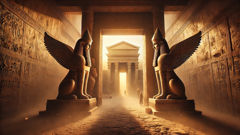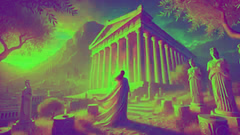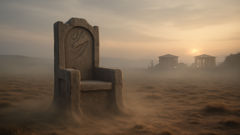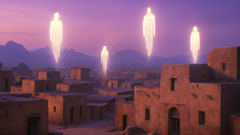Introduction
On the hot horizon where the Euphrates and Tigris bend like woven reeds, the city rose in tiers of mud-brick and cedar: stairways, courtyards, and colonnades each held a breath of incense and the echo of sandals. At each great entrance, where dust settled and the sun seared stone, there stood the Lamassu—colossal figures carved by men who believed the world needed watching. They were bulls in bone and muscle, with wings folded against broad flanks and faces shaped in the careful likeness of a thinking thing. Not quite human and not merely animal, the Lamassu held both the quiet authority of an elder and the sharp awareness of a sentinel. Their eyes, polished by artisans to catch the dawn like still pools, held the city’s name in a gaze that refused to leave.
This tale moves through the rhythm of the chisel and the slow rites that gave the guardians their breath: cedar oil poured into the cracks, prayers carved in cuneiform, offerings left at the foot of their plinths. It listens for the stories that could not be written on clay tablets—stories told in the nighttime hush beneath their shadow, when palace servants whispered the decisions of kings and children made dares across their hooves. We will follow a sculptor whose hands learned to read the grain of stone like a map, a king who came to consult the Lamassu as though they were trusted counselors, and a people who relied on these carved watchers for a sense of order in a world of sudden storms and shifting borders. In memory and myth, their presence condensed centuries; in the flicker of lamp-light they became both law and lullaby. Across the centuries of Iraq, the lamassu would witness triumph and ruin, kiss of rain and the dry rustle of conquest. This is the story of how guardians are made, how they listen, and how they teach us to look outward and inward at the same time.
Carvers of Breath: The Making of Guardians
They spoke of the first Lamassu as if it had been born rather than hewn, and in the telling the difference blurred. The sculptors called themselves masarru—the shapers—and their trade was as much prayer as it was craft. In a workshop lined with cedar planks and sun-bleached ropes, a young carver named Ashur-ili learned his apprenticeship by touch. The limestone blocks arrived from quarries that tasted of wind and distant rain; the masters tapped each surface with a mallet and listened for the note that promised a heart. “Listen to the stone,” his teacher said, fingers steady as the pulse of a sleeping animal, “and the stone will tell you where the eye must sleep and where the wing must begin.”
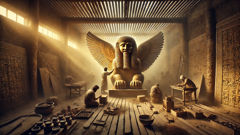
He learned to map the grain like a river; cracks became valleys to be skirted, veins of darker hue became the shadow of a brow. The first cuts were ceremonial: a sliver removed as an offering, a small bowl of fig wine set at the stone’s foot. The Lamassu’s face had to be patient—neither a stranger’s nor a king’s, but something that recognized both when they stood before it. Masters mixed pigments with crushed minerals to test color on clay; they rubbed oil into the surface to watch how sunlight would travel across a cheek or the curve of a muzzle. Wings were imagined first on paper, then set against the stone with charcoal lines so the carver might judge their sweep against the body’s bulk. The bull’s legs were anchored wide, not for motion but for permanence; the wings suggested readiness.
There were rituals done in private. At dusk, the team guarded the work with lanterns, chanting names of protective spirits so the Lamassu might inherit their vigilance. They pressed tablets into the pedestal—inscriptions that read of the city, the year, the king’s will—and then smoothed the clay away as if to hide a secret that only gods and guardians should read. When the statue was complete, a ceremony took place at the gate: incense burned until the sky reddened, dancers circled, and the king would lay a hand on the creature’s flank as if accepting an oath. For some kings, the Lamassu were more than stone; they were counselors. Amulets and petitions would be tucked into niches carved beneath the hooves; citizens, from merchants to scribes, left offerings at night—bread, barley, oil—hoping to secure the favor of a face that never blinked.
Ashur-ili thought of his hands as a bridge between human breath and silent vigilance. He made the face with lines borrowed from his mother’s freckled brow and his father’s stern mouth; he imagined a mind behind those eyes that would understand both mercy and measure. He listened to elders who insisted that the Lamassu possessed a kind of borrowed consciousness: when storms came, some swore the statue’s shadow lengthened to point toward shelter; in the winter of lean harvests, food left at their feet vanished overnight. Others said this was the work of thieves or of people moved by compassion to redistribute offerings. Yet there were nights when the air itself felt attentive, as if the winged forms had absorbed the city’s anxieties and held them steady. The masarru recorded these tales in the margins of clay tablets, not as proof but as an extension of the living contract between maker, king, and city.
Not all Lamassu were the same. Some bore the propitious inscription of Ashurnasirpal or Sargon, others the patient lettering of obscure governors whose names have been swallowed by sand. Some faced the plain and some the river. Those placed at palace gates were carved with the precision of law-readers, their moustaches and curls formed into patterns that echoed royal garments. The ones at temple steps wore carved necklaces and were cited by priests who declared their frontal stances defensive of deity as well as sovereign. Each guardian stood on a plinth that cataloged its reason for being, and in the reading of those lines a citizen could find reassurance: a guardian had been commissioned in the third year of a drought; another had been set to watch over a hospital for returning soldiers; another had been dedicated to the safety of grain stores.
The process of creation became a public story. Children were taken to see the new statues and dared to touch a hoof for luck. Merchants measured wealth by the number of guardians that lined the market’s streets. When a Lamassu was delivered to its gate, teams of oxen pulled it on rollers, and women sang old songs to ease its passage. They anchored it carefully, set its face toward the threshold, and then walked away as if having left a living thing with an obligation. The guardian would stay, a mute witness to negotiations, births, and funerals; to the passing of seasons, and to the cruelty and tenderness of men. In their patient presence people learned to measure time not only by kings’ reigns but by the slow weathering of a cheek or the polish acquired where a thousand hands had rubbed a smooth horn for good fortune.
Over time, the Lamassu’s purpose broadened from protection to counsel. There were courtiers who claimed to hear a voice when they leaned close to a carved ear—an old cadence that suggested fate not in pronouncements but in reminders: remember to be just, weigh mercy with law, guard the weak. This was the Lamassu’s true gift in the mythic telling: an externalization of the city’s conscience. The guardians could not judge, but they reflected back to the people what the city needed to see. When a king became too proud, courtiers would leave a tarnished necklace by a statue’s hoof and speak in startled voices about a shadow that had crossed its brow; whether the king believed was less important than the lesson that followed. The Lamassu taught attention through presence. To live under a guardian’s gaze was to grow careful with one’s own look.
As the years went on, rival powers and shifting borders tested the Lamassu’s promise. Caravans of fortune-seekers moved through the city like ephemeral storms; conquerors studied the guardians with an eye for plunder, not piety. When armies arrived and the palace gates fell open, some Lamassu remained intact while others were broken, toppled, or borne away. The scars they accumulated—missing horns, arms smoothed by centuries of hand-touch—became part of their identity. Even in ruin, they taught resilience: a repaired wing, reattached by later hands, told of a people who refused to let memory be erased. In whispered tavern corners, old masarru would tell how they had buried a tablet beneath a Lamassu’s plinth, what names it listed, and why the carving had been dedicated. Those stories became compasses, guiding descendants toward places where past care had once anchored community.
The Lamassu endured not because of stone alone but because of the stories folded into them. They were repositories of civic memory—stones that remembered festivals, weddings, invasions, and droughts—and the ritual practices around them kept those memories alive. When invaders spoke of gods, the Lamassu responded by being indifferent and therefore more faithful: they refused worship as gods, but in bearing witness they became meta-gods of continuity. It is in this role—stone as mirror, guardian as conscience—that they entered the deeper myth: a belief that the city’s survival depended not solely upon walls and soldiers, but upon a shared attention. In a landscape prone to sudden floods and human upheaval, the Lamassu taught a quiet discipline: to make with care, to watch with humility, and to understand that vigilance is a civic art as much as a military one.
The Guardians’ Hours: Stories Under Their Shadow
There is a popular story told among the river traders of how the Lamassu once guided a caravan through a night of uncanny fog. The leader, a woman named Tashmetu, had lost her son to fever and clung to the caravan as if it were a raft. She stopped at a gate where two Lamassu faced outward, breath visible in the cold. The traders insisted it was nothing but wind and superstition, but Tashmetu swore the statues aligned their faces just enough to show the way of a hidden ford. They turned the caravan and found firm ground where they had expected quicksand. Whether the guardians moved or whether the humans simply read meaning into what they needed, the story spread and became instruction: when a Lamassu is near, listen with more than your ears. This story, like many, blurred the line between protective myth and practical caution—signals that a people used to survive.
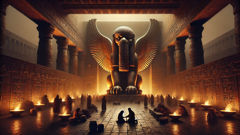
Palace life gave rise to more solemn accounts. Kings were fond of consulting symbols; some appointed diviners to interpret omens in the patterns of a guardian’s feathers or the shadow of a wing at noon. One king, fierce and magnificent, would pace the threshold in the pre-dawn and ask the Lamassu for counsel. He did not ask for commands; he sought the steadiness of a face that would not be startled by flattery. A playwright wrote later that the Lamassu taught rulers the language of listening: to bend an ear toward petitions and silence hubris, to adjudicate by memory as much as by law. In this way the guardians became the public’s conscience embodied in basalt.
Not all tales spoke of miracles. There are darker memories, too. In times of siege the Lamassu sometimes became a place where grief was concentrated. Mothers would press hands to their hooves and mutter names into the stone, as if tuneless prayers might be preserved between cracks. When invaders came and took banners, they sometimes defiled the statues, carving into faces or gouging out eyes. The violence inflicted upon the Lamassu became a measure of injustice: to harm a guardian was to try to unmake the city’s memory. In the aftermath, the survivors mended what they could. They repointed fragments and reattached limbs with iron pins, and those repairs told a new story—one of repair and the stubbornness of civic identity.
There were also intimate, human tales of secret meetings conducted in the shadow of a guardian. Lovers met where the stone bent away from the sun, trading vows with the impassive face as witness. Rebels left manifestos hidden beneath the plinth, daring history to discover them. Priests used the space for rites that fused state and temple, preparing oaths that both bound and unbound men in service. As a meeting place the Lamassu was both neutral and charged: neutral because stone is patient, charged because the public nature of its stance meant that the city itself seemed to listen. In the hush following a skirmish or a decree, the Lamassu’s presence offered a quiet assurance that life would continue, that someone—something—was paying attention.
When the empire’s fortunes waned and cities were sacked, Lamassu turned into relics of a vanished order. They were transported, sometimes whole, sometimes in pieces, to other courts where they stood as trophies or were reinterpreted as foreign wonders. A Lamassu taken to a distant palace lost nothing of its magnitude, but it did lose a piece of its story: the names on its pedestal, the coin tucked in a hoof, the whispered petitions. Yet paradoxically, movement spread legend. A guardian placed before a new king came to be a bridge between worlds: though separated from its city, it transplanted memory and inspired new narratives. Travelers spun tales of encountering guardians in the bazaars of far realms, and these stories stitched a cultural thread through a patchwork of lands.
Centuries later, the Lamassu’s fame returned under different lights. Antiquarians and later museum-goers read their inscriptions as history; scholars deciphered the cuneiform and catalogued lineages of kings. This renewed attention was a strange rebirth: the guardians became subjects of study, their mythic dimensions compressed into scholarly footnotes. Yet even amid glass cases and white-walled galleries they retained a certain stubborn presence. People still paused; some touched the protective glass as if to make contact with the original stone guardians. For refugees and exiles whose families once traced ancestry to the cities the Lamassu had watched, the statues carried a sentimental gravity that textbooks could not measure. Photographs and plaster casts spread images across continents, ensuring that even when the stones left their land, their faces continued to watch.
In more recent memory, the Lamassu faced new dangers. Wars in the modern age placed them in the path of deliberate destruction and illicit trade. When images circulated of toppled guardians or damaged bas-reliefs, the pain felt communal: it was not just archaeological loss but a wound to identity. In response, there were urgent efforts to document, photograph, and sometimes repatriate broken pieces. International teams worked with Iraqi conservators to piece fragments together, to record the inscriptions, and to protect what remained. These efforts became, for many, acts of cultural stewardship and defiance. When a Lamassu could not be saved, its imprint—detailed drawings, recorded names, and stories—served as a version of presence that refused oblivion.
Throughout, the Lamassu’s moral remained subtle. They were not moralists in the direct sense; they did not proclaim simple laws of right and wrong. Instead, their teaching was quiet and civic: pay attention to what's at your threshold, repair what is broken, carry your stories with responsibility, and safeguard what binds a community together. The wisdom of a guardian is the wisdom of a living city: attention, memory, and repair. In the marketplaces where the old men swapped stories and in the university halls where scholars debated translation, the Lamassu’s lesson was repeated in many forms. And in homes where parents told children to touch a smooth hoof for luck, the Lamassu remained as close as ever—less a relic and more a ritual, a promise that someone unseen will watch while you cross the street, bargain in the sun, and sleep tonight knowing the city keeps its own counsel.
Conclusion
Stone is patient, but it is not indifferent. The Lamassu held no dominion over fate; it offered instead the slow, steady discipline of witness. Across the rise and fall of palaces and empires in the lands we now call Iraq, these human-headed, winged guardians endured as a civic mirror, reflecting a city’s values back to itself. They taught rulers to listen, citizens to remember, and masarru to treat craft as a sacred contract. In moments of loss, their damaged faces and repaired wings became emblems of resilience; in quieter times, their presence cultivated attention to ordinary acts—repair, mercy, the keeping of promises. As modern hands trace the contours of their horns in museums or reassemble fragments in dusty labs, those hands enact the very ethic the Lamassu modeled: care. To honor a guardian is not merely to preserve stone, but to maintain the practices that made it meaningful: telling stories, weighing justice, and repairing what has been broken. In that keeping, the Lamassu continues to watch, and we continue to learn how to live under its patient gaze.

